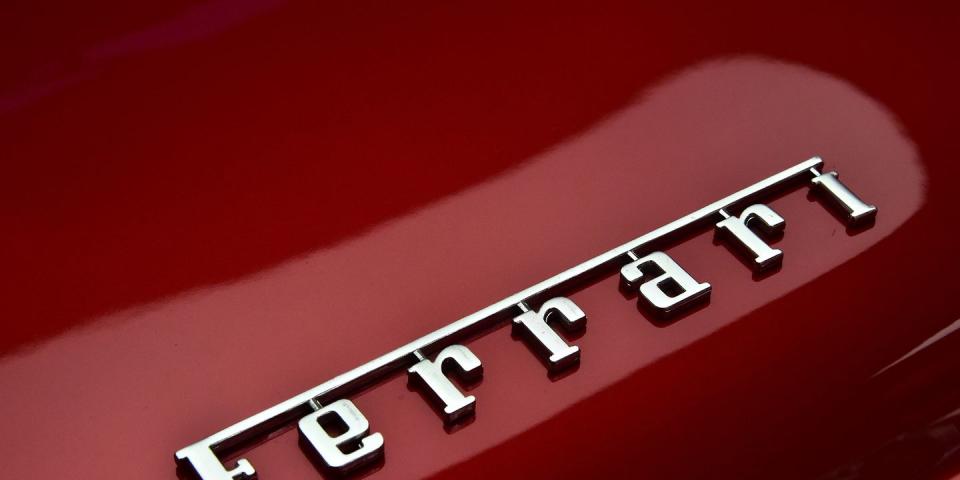Ferrari Patents Novel Method for Making Turbocharged Engines Sound Better

There is little question that turbocharging an engine carries with it performance and fuel-economy benefits. Most also agree, however, that turbos have a knack for muffling engine noise, lowering the tone of the exhaust note, and layering on whooshing sounds. That’s no fun, particularly for brands that have built cult followings around the glorious exhaust notes of their naturally aspirated engines-and chief among those is Ferrari. Well, the prancing-horse brand has filed a patent indicating it wants to charge into the turbocharged future with its exhaust notes being anything but boring.
Ferrari’s application, published with the European Patent Office last week, lays out a forced-induction arrangement focused equally on improving the turbo’s efficiency and engine power while diminishing the muffling sound turbos generally generate. The first part is reasonably standard stuff, but first, a primer on turbos: A normal turbocharger places a turbine in the exhaust piping that, when spun by the gases exiting the combustion chamber, turns a compressor wheel that forces more air mass into the engine’s intake to boost horsepower and torque.
Ferrari’s new system uses a turbine in the exhaust plumbing to spin a generator, which in turn sends power to a battery for storage or straight on to an electrically driven supercharger that stuffs air into the engine’s intake. This differs from a regular turbo, or even an electric turbocharger, in that there is no physical connection between the turbine and impeller wheels. (Standard electric superchargers make do without the turbine, instead relying solely on the existing electrical network to power a compressor.) Separating the exhaust-driven turbine (and its attendant generator) from the compressor enables automakers to mine energy stored in a battery or capacitor to spin up the compressor immediately, even in the absence of significant enough energy in the exhaust to spin the turbine-eliminating the lag that can afflict traditional turbos.
Such a forced-induction system can be mated to a hybrid powertrain’s electric motor unit and/or share a common energy storage device (battery or capacitor), and Ferrari’s patent points out this possibility. Just as energy drawn from the exhaust turbine can be stored for later deployment to a drive motor or the compressor acting on the intake, energy recuperated during regenerative braking can also be used to spin up the compressor wheel and power the drive motor when accelerating from a stop. Again, this is par for electric turbo technology these days, as found in current Formula 1 cars; even though such systems aren’t yet available in production vehicles, a variety of automakers and suppliers are working on them.
In today’s regular turbos, the exhaust turbines can only spin so fast. Wastegates, which direct exhaust gas away from the turbine, limit their speed so as not to make too much boost on the compressor side of things. By removing this connection, the engine computer can determine boost independent of the turbine’s speed (as an electric supercharger can). The engine still gets the efficiency of harvesting wasted energy in the exhaust, but none of the restraints, while paying a slight weight penalty because there are two electric motors in this system as opposed to one in the electric-turbocharger setup.
The Italian sports-car maker’s big breakthrough pertains to the sound of these systems. As Ferrari notes in its patent filing, the turbine situated in the exhaust can be used to raise the pitch and tone of the exhaust noise flowing through the pipes. The Ferrari patent claims that by varying the draw from the e-turbo’s electric generator, the automaker can tune the exhaust to emit a more “pleasing” and less muffled exhaust sound. Therefore, in some situations Ferrari is sacrificing efficiency in the name of more desirable sounds.
In the Battle between Superchargers and Turbochargers, There’s a Clear Winner. For Now.
Electrification Might Be the Answer to the Turbocharger’s Biggest Problem
What controls this action? you ask. It’s a microphone placed in the car’s cabin-Ferrari suggests near the driver’s head-that would serve to guide the engine computer in letting that exhaust turbine loose for more exhaust shriek. According to Ferrari’s filing, given how the “control method can only be used when desired,” it “therefore has no relevant negative effect on the overall energy efficiency.” Consider us down for no fuel-economy drawbacks for the same turbo thrust and engine sounds a cut above the turbocharged norm. Here’s hoping Ferrari fits it to a production vehicle soon. The brand is rapidly spreading turbos throughout its eight-cylinder lineup, leaving only its 12-cylinder models to keep the traditional wailing Ferrari exhaust tone alive. At least until technology saves the day.
('You Might Also Like',)

 Yahoo Finance
Yahoo Finance 